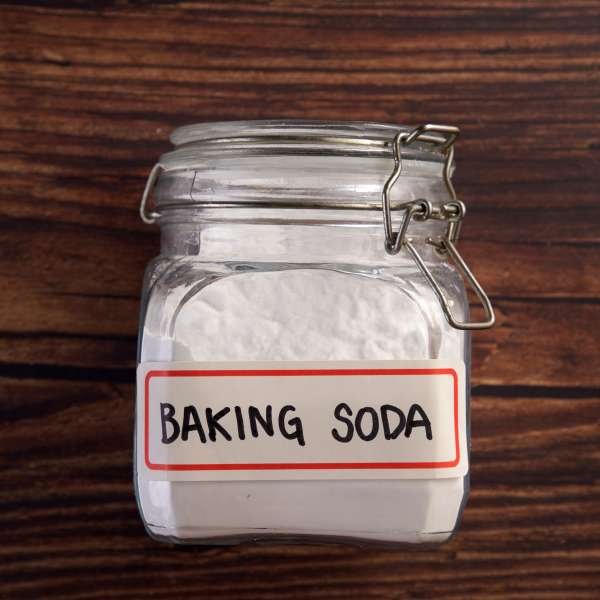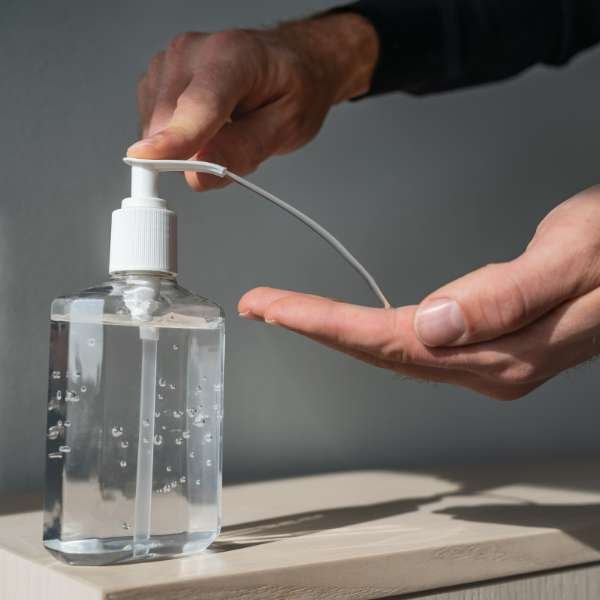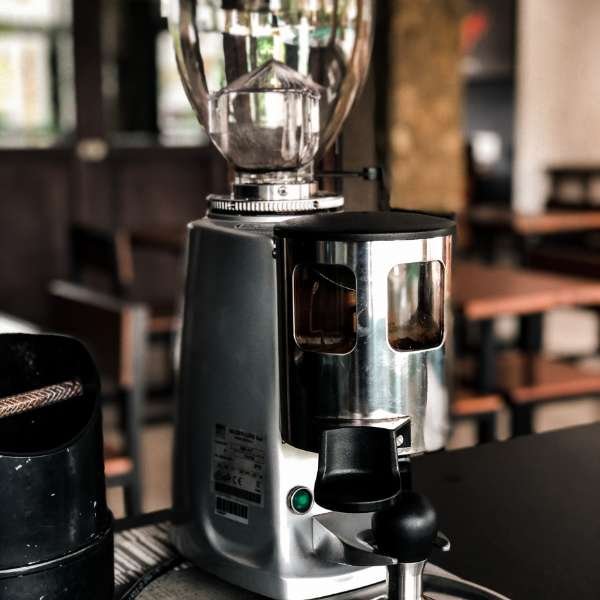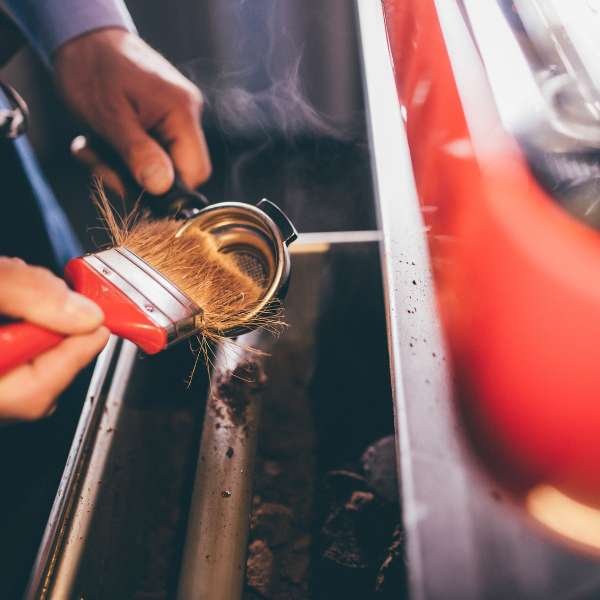A spotless coffee maker is the secret to a perfect brew, but for many, the thought of using vinegar to clean it is far from appealing. Vinegar, while effective, leaves behind an odor and aftertaste that’s hard to shake. Fortunately, there are plenty of alternatives that clean just as well without these drawbacks. In this guide, we’ll reveal how to use everyday items like baking soda, hydrogen peroxide, and lemon juice to keep your coffee maker pristine, ensuring each cup of coffee tastes just as it should—pure and delightful, without the unwanted traces of vinegar.
Why Sidestep Vinegar?

Vinegar, often heralded as a universal cleaning marvel, might not always be your best bet when it comes to your espresso machine. Its strong scent has a way of clinging on, sneaking into subsequent brews and disrupting the delicate flavor notes of your coffee. Furthermore, the acidic nature of vinegar can be corrosive to the internal components of your machine, especially with frequent use. While it’s a staple in many households, true aficionados of the morning brew frequently seek out alternatives. Fortunately, there are several potent methods available to clean your espresso machine without relying on vinegar, each one preserving the integrity of your appliance and the purity of your brew.
The Vinegar Dilemma: Potential Pitfalls

Cleaning with vinegar can lead to a host of issues. Beyond its tenacious odor, the acidic residue can accumulate within the machine, slowly eroding its performance. For those with refined palates, even a whisper of vinegar can throw off the delicate balance of flavors in a well-prepared cup. Moreover, if not thoroughly rinsed, vinegar can react with the oils and residues inside the machine, resulting in unpleasant aftertastes. Given these potential complications, exploring alternative cleaning solutions becomes less a choice and more a necessity for the discerning coffee lover.
The Appeal of Alternative Cleaning Methods

Alternative cleaning techniques provide a gentler yet equally powerful approach to maintaining your espresso machine. These methods often utilize natural ingredients that are less abrasive, thereby ensuring that your appliance remains in optimal condition for an extended period. Moreover, they bypass the harsh chemical smells that sometimes accompany traditional cleaning agents, leaving your kitchen smelling fresh and inviting. Most importantly, these alternatives protect the flavor profile of your coffee, ensuring that each cup remains as delightful as the last.
Gather Your Supplies: Essentials for a Vinegar-Free Clean

To cleanse your machine without the use of vinegar, gather a few basic supplies—most of which you likely already have stashed in your kitchen. These include baking soda, lemon juice, hydrogen peroxide, dish soap, and a soft cloth or sponge. Each ingredient plays a distinct role in the cleaning process, ensuring that every part of your espresso machine is thoroughly cleaned without the need for harsh chemicals. The tools required are just as simple: a measuring spoon, a small brush for scrubbing, and a container to mix your cleaning solutions.
Natural and Safe Cleaning Agents for Your Espresso Machine

When selecting your cleaning agents, it’s crucial to choose ones that are both effective and safe for regular use. Baking soda serves as a potent deodorizer and mild abrasive, making it ideal for eliminating stubborn stains and odors. Lemon juice, with its natural acidity, breaks down mineral deposits while leaving a refreshing scent in its wake. Hydrogen peroxide acts as a gentle disinfectant, sanitizing without leaving harmful residues. Dish soap, a kitchen staple, effortlessly cuts through grease and grime. These natural ingredients ensure that your machine is not only clean but also safe for brewing your next cup of coffee.
Pre-Cleaning Preparation:

Unplug, Disassemble, and Prep
Before embarking on the cleaning journey, it’s vital to unplug your machine and allow it to cool completely. Disassembling the espresso machine—removing the carafe, filter basket, and any other detachable parts—enables you to clean each component thoroughly. This step is crucial to ensuring that no part of the machine is overlooked, thereby reducing the risk of mold or bacterial growth. Proper disassembly also helps prevent damage during the cleaning process, especially when abrasive materials like baking soda are in play.

The Critical Step: Removing Residual Grounds
Residual coffee grounds can trap oils and other substances that contribute to unpleasant odors and flavors within your machine. Over time, these residues can accumulate, leading to blockages and diminishing the machine’s efficiency. By meticulously removing these grounds before cleaning, you pave the way for an effective cleaning process. This step also prevents the grounds from mixing with your cleaning agents, which could cause further issues or leave unwanted residues behind.
Baking Soda:

The Magic of a Gentle Scrub
Baking soda is a versatile cleaning agent, excelling in removing stains and neutralizing odors. Its mildly abrasive texture works wonders in scrubbing away stubborn residues without scratching or damaging the machine’s surfaces. Additionally, baking soda acts as a natural deodorizer, making it perfect for eradicating any lingering odors that could affect the taste of future brews. Its alkaline nature further aids in breaking down acidic compounds, ensuring that your machine is not only spotless but also free from potentially harmful residues.
Step-by-Step Guide: Cleaning with Baking Soda

Start by mixing a tablespoon of baking soda with a cup of warm water, stirring until the soda dissolves completely. Pour this mixture into the water reservoir, then run a brew cycle as if you were making coffee. Once the cycle is complete, discard the solution and rinse the reservoir thoroughly with clean water. For the carafe and other removable parts, create a paste by combining baking soda with a small amount of water, then scrub gently using a soft cloth or brush. Ensure all parts are rinsed thoroughly to remove any baking soda residue before reassembling the espresso machine.
Lemon Juice:

Unleashing Natural Acidity
Lemon juice, a powerful natural cleaner, boasts high levels of citric acid, making it particularly effective at breaking down mineral deposits and other residues that can accumulate over time. Unlike vinegar, lemon juice leaves behind a pleasant, fresh scent that won’t interfere with the flavor of your coffee. Its natural properties make it an excellent choice for those seeking to clean their espresso machine without resorting to harsh chemicals or artificial fragrances.
Detailed Process: Cleaning with Lemon Juice

To cleanse your machine with lemon juice, start by mixing the juice of two lemons with a cup of warm water. Pour this mixture into the water reservoir and run a brew cycle. As the solution passes through the machine, it will dissolve mineral deposits and other residues, leaving the appliance clean and refreshed. After the cycle is complete, run two or three additional cycles with clean water to flush out any remaining lemon juice. For removable parts, soak them in a mixture of lemon juice and water for about 15 minutes, then scrub gently before rinsing and reassembling.
Hydrogen Peroxide:

Harnessing Oxidizing Power
Hydrogen peroxide is a potent disinfectant that effectively eradicates bacteria and other microorganisms without leaving harmful residues. Its oxidizing properties make it especially adept at breaking down organic matter, such as oils and residues, that can accumulate inside your espresso machine. Hydrogen peroxide also has the advantage of being odorless, ensuring that it won’t interfere with the flavor of your coffee. When used correctly, it provides a thorough clean that leaves your machine sanitized and ready for use.
A Complete Guide: Using Hydrogen Peroxide Safely

To use hydrogen peroxide, mix equal parts of the peroxide and water, then pour the solution into the water reservoir. Run a brew cycle to allow the solution to pass through the machine, effectively sanitizing and cleaning the internal components. After the cycle is complete, run two or three additional cycles with clean water to ensure all traces of hydrogen peroxide are removed. For removable parts, soak them in the hydrogen peroxide solution for about 10 minutes, then rinse thoroughly and dry before reassembling the machine.
Dish Soap and Warm Water:

The Simplicity of Clean
Dish soap is a simple yet highly effective cleaning agent, especially when paired with warm water. It works by breaking down the oils and residues left behind by coffee, ensuring that your espresso machine is thoroughly cleaned without the need for harsh chemicals. Dish soap is also safe to use on a variety of surfaces, making it ideal for cleaning both the interior and exterior of your machine. Its grease-cutting power makes it an indispensable tool in your cleaning arsenal.
Proper Rinsing: The Crucial Last Step

After cleaning your machine with dish soap, it’s imperative to rinse the equipment thoroughly to remove any soap residue. Begin by filling the water reservoir with clean, warm water, then run a brew cycle to flush out any remaining soap. Repeat this process two or three times to ensure that the machine is completely rinsed. For removable parts, rinse them under running water until all traces of soap are gone, then dry them thoroughly before reassembling.
The Magic of Cleaning Tablets:

Convenience Unleashed
Commercial cleaning tablets are specifically formulated to clean coffee makers and other appliances, offering a convenient and effective solution for those who prefer not to use homemade cleaners. These tablets contain a blend of ingredients designed to break down residues, remove stains, and sanitize the equipment. They are easy to use and provide a comprehensive clean, ensuring that your machine remains in top condition.
Instructions for Using Tablets Effectively
To use cleaning tablets, follow the manufacturer’s instructions closely. Typically, you’ll need to place one tablet in the water reservoir, fill the reservoir with water, and run a brew cycle. As the tablet dissolves, it releases cleaning agents that break down residues and sanitize the machine. After the cycle is complete, run one or two additional cycles with clean water to rinse out any remaining cleaning agents. This process guarantees that your machine is clean, fresh, and ready to brew your next cup of coffee.
Cleaning with Rubbing Alcohol:

A Powerful Solution
Rubbing alcohol, or isopropyl alcohol, is a robust disinfectant that can be used to clean various household items, including espresso machines. However, it’s crucial to use it sparingly and with caution, as it is a potent substance. When used correctly, rubbing alcohol effectively sanitizes the machine, killing bacteria and other microorganisms that may be lurking inside. It evaporates quickly, leaving no residue, but it’s important to rinse thoroughly after use to ensure no traces remain.
Step-by-Step Process: Using Rubbing Alcohol

To clean your espresso machine with rubbing alcohol, dilute it with water at a ratio of 1:1. Pour the solution into the water reservoir, then run a brew cycle to allow the alcohol to clean the internal components. After the cycle is complete, run several additional cycles with clean water to flush out any remaining alcohol. For removable parts, soak them in the diluted alcohol solution for a few minutes, then rinse thoroughly and dry before reassembling.
Activated Charcoal:

A Natural Deodorizer Extraordinaire
Activated charcoal is an incredibly effective natural deodorizer, capable of absorbing odors and impurities from the air and surfaces. When used to clean an espresso machine, it works by trapping and neutralizing odors that can affect the flavor of your coffee. Activated charcoal is non-toxic and safe to use, making it an excellent choice for those who want to keep their machine fresh without resorting to harsh chemicals.
Incorporating Charcoal into Your Cleaning Routine
To use activated charcoal in your espresso machine, place a small amount of charcoal in a cloth or mesh bag and insert it into the water reservoir or another part of the machine. Leave it in place for several hours or overnight to allow the charcoal to absorb any odors. After removing the charcoal, rinse the machine thoroughly with clean water. You can also use charcoal to deodorize the carafe and other removable parts by placing it in the same manner and leaving it for a few hours.
Cleaning with Citric Acid:

A Citrus Solution
Citric acid, found naturally in citrus fruits, offers a safe and effective alternative to vinegar for cleaning espresso machines. Its mild acidity allows it to break down mineral deposits and residues without damaging the internal components of the machine. Unlike vinegar, citric acid leaves behind a neutral scent, ensuring that your coffee remains free from any unwanted odors.
How to Mix and Apply Citric Acid for Cleaning
To clean your espresso machine with citric acid, dissolve one or two tablespoons of citric acid powder in a cup of warm water. Pour the solution into the water reservoir and run a brew cycle to allow the acid to clean the machine. After the cycle is complete, run one or two additional cycles with clean water to rinse out any remaining citric acid. For removable parts, soak them in the citric acid solution for about 15 minutes, then rinse thoroughly and dry before reassembling.
Rice:

A Surprisingly Effective Cleaner
Rice, with its natural abrasiveness, can be a highly effective tool for scrubbing the interior of your espresso machine, removing mineral deposits and residues. Its small, grainy texture is perfect for reaching into hard-to-clean areas, ensuring that your machine is thoroughly cleansed. Rice is also safe to use on various surfaces, making it an ideal choice for those who prefer to avoid harsh chemicals.
Step-by-Step Guide: Cleaning with Rice

To clean your espresso machine with rice, fill the carafe or water reservoir with warm water and add a handful of uncooked rice. Swirl the mixture around to allow the rice to scrub away any mineral deposits or residues. For particularly stubborn stains, you can let the rice sit in the water for a few minutes before scrubbing. After cleaning, rinse the carafe or water reservoir thoroughly with clean water to remove any remaining rice or residue.
Keeping the Exterior Spotless:

A Shiny Finish
The exterior of your espresso machine deserves as much attention as the interior. Over time, the outer surface can accumulate dust, fingerprints, and other residues, detracting from the overall appearance. Regularly cleaning the exterior not only keeps your machine looking its best but also prevents any dirt or grime from finding its way inside.
Polishing for a Sparkling Finish
To keep the exterior of your espresso machine spotless, use a soft cloth or sponge dampened with warm water and a small amount of dish soap. Wipe down the surface, paying special attention to any buttons, knobs, or other areas that may collect dirt. After cleaning, dry the surface with a clean cloth to prevent water spots. For a sparkling finish, you can also polish the exterior with a small amount of olive oil or a stainless steel cleaner, depending on the material of your machine.
Maintaining the Pot and Carafe:

Crystal Clear Every Time
The pot, or carafe, is one of the most crucial components of your espresso machine, as it holds the coffee you drink. Over time, the carafe can develop stains and residues that may affect the flavor of your coffee. To clean the carafe without vinegar, you can use a mixture of baking soda and warm water, or lemon juice and water. These natural cleaning agents effectively remove stains and odors, ensuring that your pot is clean and ready for use.
Tips for Keeping the Carafe Crystal Clear
To maintain a crystal-clear carafe, rinse it thoroughly after each use to prevent stains from forming. If stubborn stains appear, soak the carafe in a mixture of warm water and baking soda or lemon juice for a few hours, then scrub gently with a soft brush. Regular cleaning will help preserve the clarity of the glass and prevent any residue buildup that could alter the taste of your coffee.
Descaling with Alternative Methods:

A Crucial Routine
Descaling is the process of removing mineral deposits, or scale, that can accumulate inside your espresso machine over time. These deposits can affect the machine’s performance, leading to longer brew times, reduced water flow, and a decline in coffee quality. Regular descaling is essential for maintaining the efficiency and longevity of your machine, ensuring that your coffee tastes its best.
Using Non-Vinegar Solutions for Descaling
Several non-vinegar solutions can be used to descale your espresso machine. Citric acid, lemon juice, and commercial descaling products are all effective at removing mineral deposits without the need for vinegar. These solutions work by breaking down the scale and flushing it out, leaving your machine clean and ready to brew. By opting for these alternatives, you can avoid the potential issues associated with vinegar while still keeping your espresso machine in top condition.
How to Clean Parts: Attention to Detail

Cleaning the Filter Basket Thoroughly
The filter basket is one of the most critical parts of your espresso machine, as it holds the grounds during brewing. Over time, the basket can become clogged with oils and residues, leading to poor water flow and weak coffee. To clean the filter basket thoroughly, remove it from the machine and soak it in a mixture of warm water and dish soap. Use a small brush to scrub away any remaining grounds or residues, then rinse the basket thoroughly with clean water before replacing it in the machine.
Maintaining the Water Reservoir for Clean Coffee
The water reservoir is another key component of your espresso machine, as it holds the water used to brew your coffee. Over time, mineral deposits and other residues can build up inside the reservoir, affecting the quality of your coffee. To clean the reservoir, fill it with a mixture of warm water and your chosen cleaning solution, then run a brew cycle to flush out any deposits. After cleaning, rinse the reservoir thoroughly with clean water to remove any remaining cleaning agents.
Avoiding Common Mistakes: Tips for Success

When cleaning your espresso machine without vinegar, it’s important to avoid common mistakes that can lead to subpar results. One frequent error is using too much or too little of the cleaning agent, which can either leave residues behind or fail to clean the machine effectively. Another mistake is not rinsing thoroughly after cleaning, which can leave behind unwanted flavors or odors. By following the correct cleaning procedures and using the right amount of cleaning agents, you can avoid these pitfalls and ensure that your espresso machine is clean and ready for use.
Establishing a Regular Cleaning Schedule: Consistency is Key
Establishing a regular cleaning schedule is vital for maintaining the efficiency and longevity of your espresso machine. How often you need to clean depends on how frequently you use it, but as a general rule of thumb, aim to clean at least once a month. For those who use their machine daily, a weekly cleaning might be necessary to prevent the buildup of residues and mineral deposits. By adhering to a regular cleaning schedule, you can ensure that your machine remains in top condition and that your coffee tastes its best.
Signs It’s Time to Clean Again: What to Watch For
There are several indicators that it’s time to clean your espresso machine again. If you notice that your coffee tastes off, or if the machine takes longer to brew than usual, these could be signs that it’s time for a thorough cleaning. Other signs include a buildup of residues or mineral deposits in the water reservoir or a decrease in water flow during brewing. By paying attention to these indicators, you can ensure that your machine is cleaned as needed, keeping your coffee tasting fresh and delicious.
The Final Rinse: Ensuring No Residue Remains
A thorough final rinse is crucial for ensuring that no residues or cleaning agents remain after cleaning.Any leftover residues can affect the flavor of your coffee and may even be harmful if ingested. By running several rinse cycles with clean water after cleaning, you can flush out any remaining residues and ensure that your machine is ready to brew your next cup of coffee. This step is particularly important when using strong cleaning agents, such as hydrogen peroxide or rubbing alcohol, as these substances can leave behind traces that could affect the taste of your coffee.
The Benefits of a Clean Espresso Machine

Making coffee without electricity may seem challenging, but it’s entirely possible with a few simple methods, and it can lead to a more mindful coffee experience. Whether you’re camping, dealing with a power outage, or simply want to disconnect, brewing coffee manually with tools like a French press, pour-over, or stovetop percolator offers rich and flavorful results. One often overlooked factor in ensuring great taste is the cleanliness of your espresso machine. Keeping your machine clean prevents bitter flavors, removes coffee residue, and ensures smooth extraction. A well-maintained espresso machine not only enhances the flavor of your coffee but also prolongs the life of the equipment, reducing the need for costly repairs or replacements. Combining manual brewing with a clean espresso machine provides a deeper appreciation for each cup of coffee, even without modern conveniences.
Conclusion
Cleaning an espresso machine without vinegar is not only possible but also highly effective, offering a range of benefits that preserve the taste and longevity of your equipment. By opting for alternative methods such as baking soda, lemon juice, hydrogen peroxide, and other natural agents, you achieve a spotless, odor-free machine without the lingering scent or potential drawbacks of vinegar. These methods remain gentle on your appliance while being tough on stains and residues, ensuring every cup of coffee is brewed to perfection. Regular maintenance using these vinegar-free techniques keeps your espresso machine in optimal condition, allowing you to savor each cup with the pure, untainted flavor that you love. Whether you’re a daily coffee drinker or an occasional sipper, a clean espresso machine is the key to consistently delicious brews, every time.

